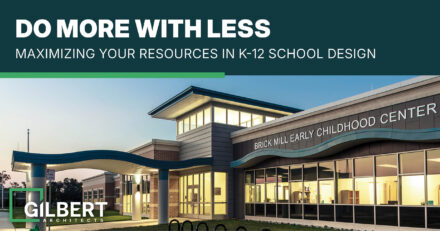
In an era where building innovation and efficiency are paramount, the way we’re creating schools is evolving.
Permanent off-site construction, also known as modular construction, is reshaping how we build educational facilities. This approach can drastically decrease project duration and disruptions while still delivering an attractive, long-lasting and functional modern educational space.
In this blog, we’ll explore the permanent off-site construction approach.
What is Permanent Off-Site Construction
 Off-site construction (also known as modular construction) is when building elements are designed, constructed, and assembled somewhere other than the construction site.
Off-site construction (also known as modular construction) is when building elements are designed, constructed, and assembled somewhere other than the construction site.
This process may conjure up ideas of temporary facilities, trailers, and low-quality buildings. But that’s far from an accurate depiction. The permanent modular construction industry has evolved to create large, custom structures that are high-quality and visually appealing.
Permanent off-site construction projects also last as long as structures created with a traditional on-site approach. They utilize the same durable building materials like concrete and steel to ensure they stand the test of time.
From multi-story entrance lobbies to technology-enhanced classrooms, permanent off-site construction can be used to create a wide range of educational spaces suited for various learning environments.
The Modular Construction Process
The permanent modular construction process can be broken down into four main steps.
1. Design
The school is thoughtfully designed with a modular approach, creating a cohesive and effective learning environment.
2a. Off-Site Construction
Qualified and competent modular construction contractors build the components in a factory-controlled environment. Most of the finishes and systems are included and tested at the factory.
2b. On-Site Construction
Meanwhile, all on-site preparations and foundations needed to accommodate the modules will be made.
3. Delivery
Once the modules are 90% complete, they’re separated, protected, and transported to the site.
4. Installation
Upon arrival, the modular construction contractor will use a crane to hoist and place the modules in their permanent positions. All systems’ connections are reconnected, tested, and the finishes are finalized.
This process results in a long-lasting, visually seamless building that’s largely indistinguishable from one constructed by traditional on-site means.
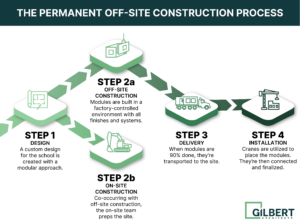
Modular Construction Cost
The cost of a permanent off-site construction project will vary greatly based on the size and scope. That said, these projects typically cost the same as comparable projects built on site.
Modular construction doesn’t require prevailing wage rates, which means labor costs tend to be lower. Reduced material waste can also help cut costs. However, the savings are typically offset by transportation and installation costs.
The Benefits of Off-Site Construction for Schools
From shortened schedules to improved quality control, modular construction offers a host of benefits.
Reduces Project Schedule
Permanent off-site construction typically results in a faster construction schedule. There are two reasons for this.
The first is that the construction of the modules takes place in a factory-controlled environment, meaning there are little to no weather-related issues or delays.
Secondly, it breaks down the typical progression of work on a construction site. Work on the building itself no longer has to wait until the site and foundation are ready. The creation of the building components can happen at the same time.
That means construction activities on campus are much shorter in duration and students and staff can move into the new building sooner.
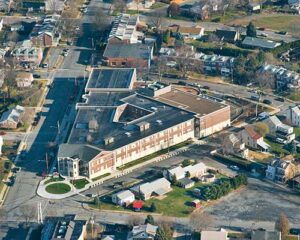 Accommodates Tight Sites
Accommodates Tight Sites
In urban environments or areas where land and space are scarce, construction can be challenging. Contractors need room for material staging, storage, parking and general laydown areas — but oftentimes, a building’s footprint is designed to take up most of the site.
With permanent modular construction, the bulk of these activities happen off-site, greatly reducing the need for much of this construction-related space.
Minimizes Disruptions to Surrounding Areas
Similarly, off-site construction often impacts the surrounding areas less than a traditional on-site construction approach. Because this approach cuts the amount of on-site work, contractor traffic, large construction equipment, noise, and dust are all reduced.
More Effective Quality Control
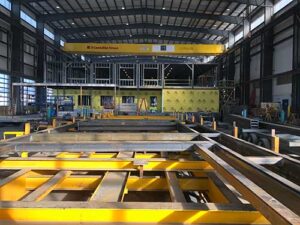 Some may see permanent modular construction as offering an inferior final product suited for temporary or rushed projects. On the contrary, permanent off-site construction typically has quality control benefits that on-site construction doesn’t have. There are a few reasons for this.
Some may see permanent modular construction as offering an inferior final product suited for temporary or rushed projects. On the contrary, permanent off-site construction typically has quality control benefits that on-site construction doesn’t have. There are a few reasons for this.
Off-site construction contractors rely on their skilled workforce who specialize in specific module components. Quality is ensured with various evaluations, reducing the likelihood of errors or variations.
Additionally, these components are made in a factory-controlled environment, where factors like precipitation, temperature, wind, and other external variables can be controlled.
Lastly, permanent off-site construction offers a higher level of consistency. Precise machinery and techniques help contractors build modules to their exact specifications with the same materials and practices. This leads to high levels of consistency across different portions of the building.
Offers Design Flexibility
The approach’s quality-enhancing standardization does not come at the cost of design flexibility. Your architect will design modules customized to meet your school’s specific requirements and aesthetic preferences which can be equally creative as traditional construction.
Additionally, a modular approach to the building makes future additions, renovations and reconfigurations easier. This will allow your district to adapt to its changing needs as demographics and the demands of learning environments evolve.
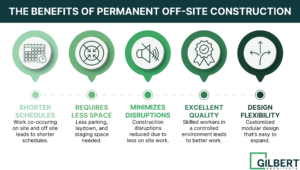
The Challenges of Modular Construction for Schools
While permanent off-site construction is a great option, there are potential challenges to consider.
May Require a Hybrid Approach
Permanent off-site construction can be used to create roomy, multi-story spaces. However, they’re not always ideal for certain areas like gyms, cafeterias and auditoriums.
To work around this, we’ve designed several projects with a hybrid approach. This is when a significant portion utilizes permanent off-site construction, and the remainder of the building is constructed on site.
As a result, the project is completed faster, and the modules flow seamlessly with the portions built on-site.
Dependency on Factory Capacity
Permanent modular construction is increasing in popularity and contractors’ availability can be tight. We have strong relationships in the off-site construction industry and have not run into this issue; however, it does remain a possibility.
Requires Seamless Coordination On-Site and Off
The work occurring both on-site and off needs to be highly coordinated. If there are issues with coordinating work and materials at either end, it could result in schedule and quality problems.
To avoid this, choosing the right project team is essential. From the design team to the contractors, you’ll want to partner with competent firms with extensive experience in permanent off-site construction.
Is Permanent Off-Site Construction Right for Your School?
Permanent off-site construction is a great option for districts looking to create new schools or expand existing ones.
This approach allows your project team to create attractive, long-lasting facilities in record time, reducing its impact on your campus and getting your staff and students in their new classrooms faster — especially on tight sites.
With the right design team, you can take advantage of all the benefits permanent off-site construction offers.
For nearly two decades, Gilbert Architects has worked with modular contractors to design and create several educational buildings, earning us the reputation as the premier permanent off-site construction designer in the Northeast for the academic sector.

